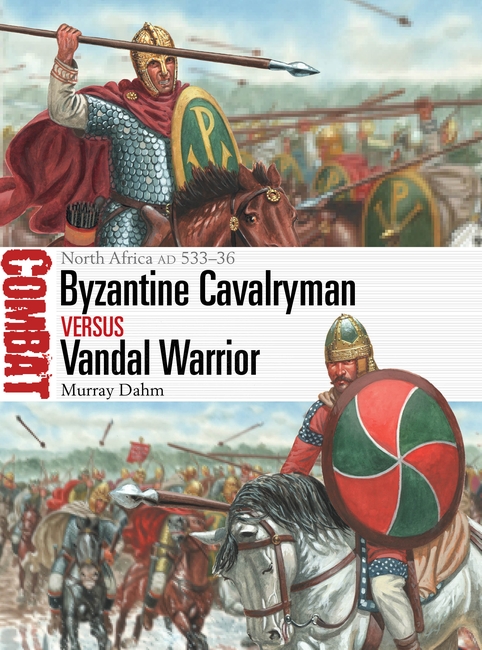
Of the many changes in Roman military organisation between the fourth and sixth centuries AD, one of the most impactful for the wars of Belisarius was increased use of the bucellarii (or boukellarioi in Greek) – privately raised forces (usually cavalry) who operated as bodyguards for commanders. It was with these troops that Belisarius delivered his decisive cavalry charges in all his battles. The historian for Belisarius’ campaigns, Procopius of Caesarea probably means bucellarii when he uses the term ‘guards’ or ‘bodyguards’; he frequently uses the term doryphoroi, (sing. doryphoros, meaning ‘spear-bearer’ or ‘bodyguard’). Belisarius had more than 1,000 bucellarii in North Africa and there seem to have been 1,100 at the decisive battle of Ad Decimum in 533. It was the bucellarii who delivered the decisive charges in Belisarius’ battles, such as those delivered by John the Armenian at the battle of Ad Decimum (Procopius 3.18.3–10) and against Tzazon by both John and Belisarius at the battle of Tricamarum (Procopius 4.3.10–13).
By the reign of the Roman emperor Honorius (r. 393–423) it was common for Roman commanders (and emperors) to hire a private body of troops to operate as a bodyguard (Olympiodorus fragment 74). Such men were often of Gothic, Alan or other barbarian stock and would be armed and armoured at the commander’s expense. The name of these troops was bucellarii. The name of the bucellarii was possibly derived from their ration of biscuit-like bread, bucellatum or buccellatum, probably similar to hard-tack. This etymology is presented to us by historians of the time such as Olympiodorus (fragment 12).
It is likely that these troops were equipped as heavy cavalry, cataphractarii or perhaps clibanarii, heavily armoured and armed with lances and swords, although they may also have had bows. Flavius Aetius probably had a force of bucellarii fighting against Attila in the 450s. One reason for thinking that the bucellarii of Belisarius were cataphractarii or clibanarii is that they often fought at massive odds in the thick of battle and yet suffered very few casualties. At Ad Decimum in 533, one unit of 300 bucellarii suffered only twelve casualties despite winning a victory at immense odds; another unit suffered only two casualties (Procopius 3.17.1, 3.23.5).
It is the possibility that Belisarius’ bucellarii were heavy clibanarii cavalry which raises an interesting possibility for these ‘biscuit-men’. The term clibanarii (or their Greek equivalents – kataphractoi and klibanarioi or klibanophoroi) may derive from klibanon (meaning ‘oven’ or ‘camp-oven’) and was taken to mean entirely encased in iron; this is exactly what Julian describes in his Second Oration written in the 350s AD: “Of these troops some carry lances and are protected by cuirasses and helmets of wrought iron mail. They wear greaves that fit the legs closely, and knee-caps, and on their thighs the same sort of iron covering. They ride their horses exactly like statues, and need no shield” (Oration 2 57B-C). Alternatively, the term may have been derived from the Persian term for these cavalry: Grivpanar (‘neck guard wearer’ from grīw-bān for neck guard). It was from the Persians that the Romans adopted such cavalry from the late third century onwards, but especially in the fourth century under the emperor Constantius II (r. 337-359 – about whom Julian was writing), and the Roman term clibanarii may have derived from the Persian. Nonetheless, the later Roman historians gloss the term to describe cavalry fully encased in iron like an oven (SHA Severus Alexander 56.5, Ammianus 16.10.8). Ammianus also uses the term ferreus equitatus (‘iron cavalry’ – 19.1.2). Ammianus’ description of the clibanarii is very close to Julian’s:
“… among them were the full-armoured cavalry (whom they called clibanarii), all masked, furnished with protecting breastplates and girt with iron belts, so that you might have supposed them statues polished by the hand of Praxiteles, not men. Thin circles of iron plates, fitted to the curves of their bodies, completely covered their limbs; so that whichever way they had to move their members, their garment fitted, so skilfully were the joinings made” (16.10.8).
The term for clibanarii seems, therefore, to have made sense to the Roman historians because the men fully encased in armour looked like ovens. For the bucellari, therefore, rather than derive their name from a biscuit-like ration, might it not be that they looked like bucelatum – that is that they wore scale armour, and the shape of the scales resembled the shape of the bucelatum. From the limited evidence available showing heavy cavalry in scale armour (such as the relief of a heavy cavalryman named Trypohon, found in Tanais (near modern-day Rostov-on-Don, Russia), this is certainly one way you could have described them!
Only a single unit of bucellarii is listed in the late fourth century Notitia Dignitatum, however: the Bucellarii iuniores. Although the exact title of the unit is not entirely clear, and some manuscripts list them as Comites catafractarii Bucellarii iuniores, this may be related to their status as cataphractarii. These were a comitatenses vexillation under the Magister Militum per Orientem; the term iuniores implies that there had been a unit of seniores at some point. This unit was not, however, a privately raised and paid for unit as they had been and would become, but listed as a regular unit in the comitatus army. Such troops became much more common in armies of the sixth century. The exploits of Belisarius’ bucellari are impressive and throughout his long military career (his last victory coming in 559) and the numbers of them he employed kept increasing. Later, he is said to have had 7,000 bucellarii in his forces. For more on Belisarius’ bucellarii and the exciting battles of his lightning reconquest of Vandal North Africa, don’t miss Combat 73: Byzantine Cavalryman versus Vandal Warrior.

Comments
You must be logged in to comment on this post. Click here to log in.
Submit your comment